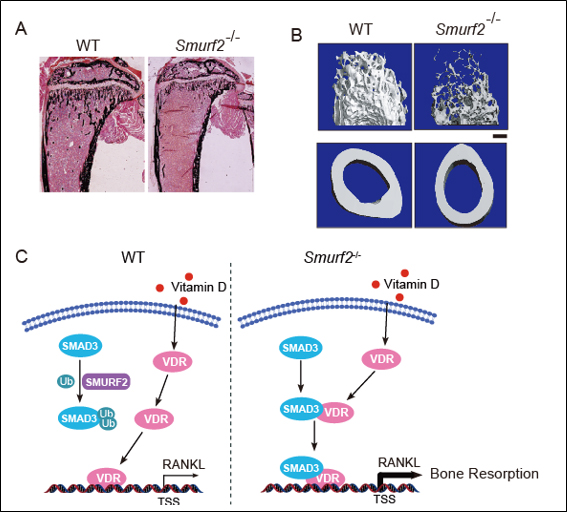On Feb.20th, 2017, Nature Communications published online a work entitled “SMURF2 regulates bone homeostasis by disrupting SMAD3 interaction with vitamin D receptor in osteoblasts” by Dr. Weiguo Zou’s group at the Shanghai Institute of Biochemistry and Cell Biology, Chinese Academy of Sciences. This work reveals that ubiquitin E3 ligase SMURF2 maintains bone homeostasis by regulating the vitamin D receptor signaling in osteoblasts. The work is a new discovery in basic research of orthopedic related disease.
The incidence of degenerative bone diseases is very high. Recently, the General Office of the State Council has issued the Medium-to-Long Term Plan of China for the Prevention and Treatment of Chronic Diseases (2017-2025), which lists skeleton diseases as one of chronic diseases, together with cardiovascular and cerebrovascular diseases, cancer, diabetes and neurological diseases, etc. Bone growth and metabolism is precisely regulated by two types of cells: osteoblasts, which form new bone tissue, and osteoclasts, which resorb old bone tissue. The complicated interaction between osteoblasts and osteoclasts makes the bone remodeling in a dynamic balance, which is crucial for homeostasis of the skeletal system. The disequilibration between these two cell types will lead to bone diseases such as osteoporosis. Currently it is estimated that over 200 million people worldwide suffer from osteoporosis, the incidence of which is much higher than other diseases, such as cancer and cardiovascular disease. Patients with osteoporosis have a higher risk of fracture, especially hip and vertebral fractures, even if they are only slightly moving or walking. Clinical studies have shown that a quarter of patients with hip fracture die within a year. Although pyrophosphate and other drugs have been widely used in clinical, they can only specifically inhibit osteoclast-mediated bone resorption, and can’t play a major role in improving bone formation or bone remodeling. So it will be conducive to the clinical treatment of osteoporosis by further strengthening the orthopedic fundamental research.
SMURF2 belongs to the Nedd4 family. Related proteins in this family have similar structures. All of them contain a catalytic HECT domain at the C-terminus, and an N-terminal region including a C2 domain and a series of WW domains. SMURF2 and SMURF1 are highly homologous proteins. According to a paper in Cell, 2005, Smurf1-/- mice display increased bone formation and bone mass. Under the supervision of Dr. Weiguo Zou, Zhan Xu and colleagues identified that SMURF1 and SMURF2 have a similar effect on osteoblast differentiation, but mice lacking SMURF2 have low bone mass (figure 1A、B), opposite to the phenotype of Smurf1-deficient mice. Smurf2-/- mice have an increase in osteoclast numbers and bone resorption, which is similar to osteoporosis symptoms. Further mechanism studies show that SMURF2 regulates RANKL expression in osteoblasts by affecting the interaction between SMAD3 and VDR (figure 1C). To identify the function of SMURF2 in osteoblasts, the researchers constructed Smurf2 osteoblast-lineage conditional knockout mice (prx1-Cre,Smurf2fl/fl). The bone phenotype of Smurf2 conditional knockout mice, showing increased RANKL expression, enhanced osteoclast differentiation and decreased bone mineral density, was similar to that of germline Smurf2-/-mice.
This study focused on the molecular mechanisms of skeletal system stability, besides indicating SMURF2 is a key factor in the process, the relevant data also show that bone remodeling and bone mineral density can be regulated by adjusting the activity of SMURF2 and interrupting the interaction between SMAD3 and VDR in osteoblasts. SMURF2, a key regulator of TGFβ signaling pathway, can regulate transcriptional activity of VDR by modulating the interaction between SMAD3 and VDR through the ubiquitination of SMAD3, which means that SMURF2 is a regulator for crosstalk between TGFβ and vitamin D signaling pathway.
The work was helped by Laurie H. Glimcher’s lab at Department of Medicine, Weill Cornell Medical College and by Roland Baron’s lab at Department of Oral Medicine, Harvard School of Dental Medicine. The Smurf2-/-mice line was provided by Jeffrey L. Wrana researcher from University of Toronto. This work was supported by grants from the National Natural Science Foundation of China, the Ministry of Science and Technology of China and the Chinese Academy of Sciences.

Figure 1:A、B:Smurf2-/- mice have low bone mass. C: SMURF2 regulates RANKL expression by adjusting the interaction between SMAD3 and VDR ( Photos provided by Weiguo Zou Group)
CONTACT:
Weiguo Zou Ph.D. Professor
Shanghai Institute of Biochemistry and Cell Biology
Chinese Academy of Sciences
SIBCB Building, Rm 1401
320 YueYang Road, Shanghai 200031, China
Tel: 86-21-54921320
Email: zouwg94@sibcb.ac.cn
 Appendix:
Appendix: